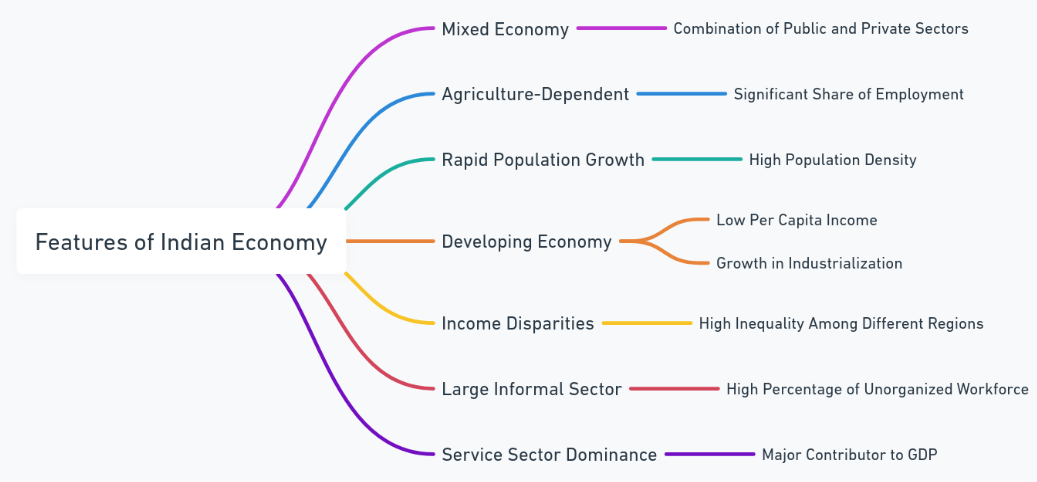The Indian economy, being a multidimensional and dynamic entity, has transformed from its traditional roots in an agrarian economy to a more global economic player with many sectors such as manufacturing, services, and technology. Because of the size of the population and some unique characteristics, the Indian economy features centrally in the global landscape of economics. The diverse economic sectors high-pressure population and steps taken to achieve planned development are distinct features of the economy. Understanding these unique features provides insight into opportunities and challenges for the country.

Features of Indian Economy
India’s economy has some very distinct characteristics, which influence its growth, development, and sustainability. All these features reflect a record of achievements and also an ongoing challenge that goes into influencing the country’s economic policies and global standing.
Inadequate Per Capita Income
The per capita income in India is much lower compared to developed economies. The dilution of the population of high density in this aspect of income is another key reason. Improvements are being seen in India as far as GDP growth goes, but per capita income remains a very crucial measure of economic inequality.
Per Capita Income Growth in India vs. Other Nations (2000-2020)
| Year | India (USD) | Developed Economies (USD) |
|---|---|---|
| 2000 | 439 | 24,850 |
| 2010 | 1,227 | 35,630 |
| 2020 | 2,104 | 46,800 |
High Population Pressure
With more than 1.3 billion people, it is the second most populated country in the world, and this level of population exerts a huge pressure upon the nation. Some such pressure areas are resources, employment, and infrastructure; at the same time, it means a huge potential of a workforce that, being tapped into effectively, might make a great contribution to the prosperity of the country.
Impact: High population pressure affects education, healthcare, and social infrastructure, and managing this effectively is key to long-term development.
Inequality and Poverty
Despite various economic reforms, stark income inequality and poor levels persist in the country. The disparities are located across various differentiations in wealth distribution between rural and urban areas and other states. Several schemes have been designed by the government to eradicate poverty, but the gap persists.
Poverty Distribution in Urban and Rural Areas
| Area | Population Below Poverty Line (%) |
|---|---|
| Rural | 25.7 |
| Urban | 13.7 |
| Overall | 21.9 |
Well-Planned Economy
India is a mixed economy model, which is the amalgamation of capitalism and socialism. Economic planning has been a significant part, with successive Five-Year Plans guiding the growth trajectory of the country. The government intervenes in certain sectors to balance economic growth with social equity by focusing on agriculture, infrastructure, and industry.
Key Plans: From the Green Revolution to the Make in India initiative, these plans focus on enhancing productivity, self-sufficiency, and employment.
Diverse Economic Sectors
The Indian economy can generally be categorized into three heads: agriculture, industry, and services. These contribute the maximum to the GDP of the country. The agricultural sector is the substantial sector, which employs a very large segment of the people. The services sector contributed the most to the country’s GDP, with important contributions coming from the sector of IT and IT-enabled services.
- Agriculture: Employs around 50% of the workforce but contributes approximately 17% to GDP.
- Industry: Represents 25-30% of GDP, with manufacturing, mining, and construction being key contributors.
- Services: The largest contributor, with over 55% of GDP, including IT, banking, and telecom sectors.
Sector-Wise Contribution to GDP (2020)
| Sector | Contribution to GDP (%) |
|---|---|
| Agriculture | 17 |
| Industry | 25 |
| Services | 58 |
Economic Reforms and Liberalization
India opened up in 1991 with the outset of economic reforms and liberalization. It reduced the regulation, privatization, and trade barriers by liberalizing the market system. It gave more scope for foreign investment and increased competition in the market, which enhanced the economic growth significantly as India became a global investment market.
- Key Reforms: Reduction in licensing requirements, removal of foreign exchange controls, and tax reforms.
- Outcome: Increased foreign direct investment (FDI), job creation, and growth in export sectors.
Infrastructure Development
India has made a lot of effort to build its infrastructure, which is the underlying pillar for sustained economic growth. Such projects as NHDP and Golden Quadrilateral have improved connectivity in terms of trade and commerce. In fact, the recent move towards smart cities further refers to efforts towards the modernization of infrastructure.
- Challenges: Despite progress, India faces challenges in power supply, water distribution, and urban infrastructure.
- Future Prospects: The government’s investment in infrastructure is expected to enhance economic productivity and attract more investment.
The Indian economy’s unique features underscore its strengths and challenges. As a mixed economy with a large population and diverse sectors, India holds growth potential but also faces hurdles such as income inequality, poverty, and infrastructural demands. Addressing these issues through sustained economic reforms, targeted infrastructure projects, and policies to mitigate poverty can bolster India’s position as a leading global economy.
Features of Indian Economy FAQs
What are the primary features of the Indian economy?
The Indian economy is marked by high population pressure, inadequate per capita income, economic diversity across sectors, and ongoing infrastructure development.
How does economic inequality impact India?
Economic inequality in India results in disparities in wealth and living standards, particularly between urban and rural populations, affecting access to education, healthcare, and employment opportunities.
Why is infrastructure development important for India’s economy?
Infrastructure development is crucial as it enhances connectivity, boosts trade, and creates job opportunities, all contributing to economic growth.
How has economic liberalization impacted India?
Economic liberalization since 1991 has increased foreign investment, improved trade, and fostered competition, making India a more open and dynamic economy.
What role does agriculture play in the Indian economy?
Agriculture employs a significant portion of the population, especially in rural areas, and is vital for food security, though it contributes a smaller share to GDP compared to services and industry.

